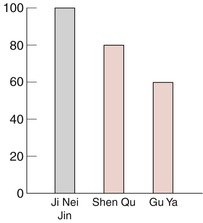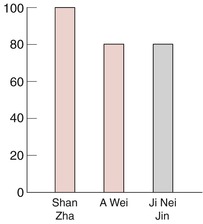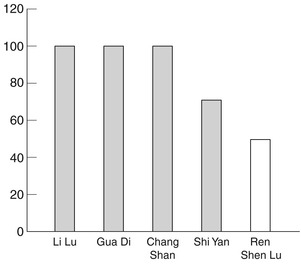Chapter Nine. Herbs that relieve food stagnation; herbs that expel parasites; herbs that induce vomiting
 |
1. What are the causes of and indications for food stagnation? What precautions should be observed when using herbs that relieve food stagnation?
Herbs that relieve food stagnation are able to promote digestion and dissolve food accumulation. Although food stagnation is not commonly seen nowadays in the developed countries because of the influence of healthy dietary principles, it may still happen in certain situations. First of all, in infants, since the Spleen and Stomach are not fully developed and the parents may lack experience or knowledge of the best diet for children, the child may suffer from indigestion. Secondly, in people with a weak constitution or who suffer from chronic disease, because the functions of the Spleen and Stomach are insufficient, food may tend to stagnate in the Middle Jiao. Thirdly, in elderly people, since the digestion slows with age, indigestion may easily happen. Acute or Excess cases of food stagnation may also occur when on holiday if the diet is changed significantly or the person overindulges.
Food stagnation is caused by the obstruction of the Qi in the Middle Jiao. The main symptoms are fullness in the stomach, belching, nausea, vomiting with a foul smell, distending pain in the abdomen and constipation or diarrhea. The tongue body is normal or slightly red and the coating is thick, white or slightly yellow. The pulse is slippery, forceful and rapid. In chronic cases of food stagnation, especially in those people with Spleen and Stomach deficiency, symptoms of Qi and Blood deficiency may appear. In children, it may affect their general health and development.
Herbs that relieve food stagnation should be used with caution because they can digest, dissolve and transport food; therefore they may injure the Stomach, Spleen, Qi and Blood too. They are generally used for only a short treatment course. When the accumulated food has been digested, these herbs should be stopped. In people who suffer from indigestion with deficiency of the Spleen and Stomach, these herbs should be used together with herbs that tonify the Spleen and Stomach. In addition, these herbs are normally not used in large dosages, and are often used together with other herbs to enhance the effect, such as herbs that promote the Qi movement, eliminate Dampness or clear Heat in the Middle Jiao. For patients who have a weakness of the Spleen and Stomach, herbs that are slightly warm in temperature are often used to warm the Middle Jiao and accelerate the function of these organs.
2. What are the characteristics of Mai Ya ( Hordei fructus germinatus), Shen Qu ( Massa medicata fermentata) and Shan Zha ( Crataegi fructus)?
These three herbs have the function of promoting digestion. Since they are often used together and are very effective for treating food stagnation, they are given a particular name: Jiao San Xian. In Chinese, ‘ Jiao’ means ‘deep-dry-fried’, ‘S an’ means ‘three’ and ‘ Xian’ means ‘immortal’. In other words, the name means ‘three very effective herbs’. These herbs are often deeply dry-fried until their colors have changed to deep brown. It is believed that they are then more easily digested and work particularly on the Middle Jiao.
These three herbs are often used together because they have different functions and can enhance each other’s therapeutic effects. Mai Ya is sweet and neutral, and enters the Spleen and Stomach meridians; it especially aids the digestion of wheat, rice and fruits. Shen Qu is pungent, sweet and warm, and enters the Spleen and Stomach meridians; it particularly aids the digestion of cereals and dispels the effects of alcohol. Shan Zha is sour, sweet and slightly warm, and enters the Spleen, Stomach and Liver meridians; it especially aids the digestion of meat, fat and milk. Because in most cases of food stagnation these foods and drinks are all involved, the three herbs are often used together.
3. Lai Fu Zi ( Raphani semen), Mai Ya ( Hordei fructus germinatus) and Gu Ya ( Oryzae fructus germinatus) are all able to aid the digestion of wheat, rice and fruits. What are the differences between their actions?
These three herbs are all used for stagnation of wheat, rice and fruits, but their strengths are different. Lai Fu Zi is the strongest; it is pungent, sweet and neutral, and enters the Lung and Spleen meridians. It can direct the Lung-Qi to descend, soothe the Stomach-Qi and promote the bowel movement. It can also eliminate Phlegm whether in the Lung or in the Stomach. Lai Fu Zi is especially suitable for use when the food stagnation causes nausea, vomiting and constipation and the tongue has a thick, sticky and white coating.
Mai Ya is gentler than Lai Fu Zi and it can dissolve stagnation of wheat, rice and fruits. But, unlike Lai Fu Zi, it has no function in promoting the Qi movement.
Gu Ya is the weakest herb of the three. It is gentle and slow in action, but its strong point is that it can tonify the Spleen and Stomach, so it can be used for a longer period of time than the others. Gu Ya can also aid the digestion of cereals, so can be used for all starchy foods. It is particularly suitable for people who suffer from indigestion in Deficiency conditions.
4. Shen Qu ( Massa medicata fermentata) and Gu Ya ( Oryzae fructus germinatus) both can aid the digestion of grains. What are the differences between their actions?
Shen Qu and Gu Ya both can aid the digestion of cereals and reduce the food stagnation, but Shen Qu is stronger than Gu Ya in action. Shen Qu is pungent, sweet and warm and is able to promote the Qi movement, soothe the Stomach-Qi, and aid the digestion of starchy foods which are heavy to the stomach, such as grains and brown bread. It is effective for reducing distension and heavy sensations in the stomach. Gu Ya is much gentler in action than Shen Qu; however, as it has tonifying ability, it can be used for a long time.
Another difference between these two herbs is that Shen Qu is able to dispel the effects of alcohol whereas Gu Ya does not.
5. What are the characteristics of Ji Nei Jin ( Gigeriae galli endothelium corneum) and Shan Zha ( Crataegi fructus)?
Ji Nei Jin and Shan Zha are two substances that are especially used to aid the digestion of meat and fat. Ji Nei Jin is sweet and slightly cold, and enters the Stomach, Spleen and Bladder meridians. It not only reduces the stagnation of meat, but also aids digestion of all other kinds of food. Its action in relieving food stagnation is quite strong and it is very effective in treating fullness in the Stomach, nausea, vomiting and diarrhea. Since it is cold in temperature, it is also able to reduce Heat and eliminate irritability. It is particularly suitable for use in children with malnutrition when the chronic food stagnation has already produced Heat.
Shan Zha is sweet, sour and slightly warm, and enters the Stomach, Spleen and Liver meridians. Besides its function of dissolving meat, fat and milk accumulations, it is able to break up congealed Blood and promote Blood circulation. It has also recently been found that this herb can lower serum cholesterol level and lower blood pressure, and has been used in the prevention and treatment of arteriosclerosis. Since this fruit has a nice sweet and sour taste, it is often used in the preparation of candy, jam or drinks and has become an ingredient in a healthy diet.
6. What are the characteristics of herbs that expel parasites? What precautions should be observed in their use?
Herbs that expel parasites are able to expel the intestinal parasites, such as roundworm, hookworm, pinworm (threadworm) and tapeworm. Some of them also have the function of eliminating fasciolopsis, schistosome and vaginal trichomonas. Most of these herbs are bitter, pungent, cold or warm, and poisonous. They enter the Stomach, Large Intestine and Spleen meridians. These herbs are not as strong as the modern antiparasitic drugs but they have much less toxicity and can be used repeatedly. They are especially suitable for children and patients suffering from liver and kidney disorders. These herbs are also very often used with other herbs to enhance their therapeutic effect of eliminating parasites and harmonizing the Yin and Yang of the body—for example, herbs that regulate the Qi, purgatives, herbs that promote the digestion, herbs that tonify the Spleen and herbs that clear Heat or warm Cold.
Since these herbs are able to eliminate parasites, most of them, more or less, are poisonous herbs, and therefore the dosage should be carefully controlled. They are usually taken on an empty stomach, are used only once or for 3 days at most as a treatment course. However, some herbs such as Nan Gua Zi ( Curcubitae semen) and Fei Zi ( Torreyae semen) are not poisonous, so can be used for a longer period of time.
7. Which herbs can expel Ascaris (roundworm)?
The herbs that are very commonly used to expel roundworm are Ku Lian Pi ( Meliae cortex) and Shi Jun Zi ( Quisqualis fructus). There are other herbs which have the same function but are not as strong as these two herbs, and they are often used together with these two herbs to accentuate the therapeutic effect. They are He Shi ( Carpesii fructus), Wu Yi ( Ulmi fructus praeparatus), Fei Zi ( Torreyae semen), Bing Lang ( Arecae semen), Nan Gua Zi ( Curcubitae semen) and Lei Wan ( Omphalia).
8. Which herbs can expel Oxyuroidea (pinworm or threadworm), Taenia (tapeworm) and Ancylostoma (hookworm)?
The herbs that can expel pinworm are Ku Lian Pi ( Meliae cortex), He Shi ( Carpesii fructus), Fei Zi ( Torreyae semen), Guan Zhong ( Dryopteridis rhizoma) and Bing Lang ( Arecae semen).
The herbs that can expel tapeworm are Bing Lang, Nan Gua Zi ( Curcubitae semen), Lei Wan ( Omphalia), Xian He Cao ( Agrimoniae herba) and Guan Zhong.
The herbs that can expel hookworm are Fei Zi, Bing Lang and Lei Wan.
9. What are the characteristics of Shi Jun Zi ( Quisqualis fructus) and Ku Lian Pi ( Meliae cortex)?
Shi Jun Zi and Ku Lian Pi are both effective for expelling roundworm. Shi Jun Zi is sweet and warm, and has a nice smell and taste. As well as expelling roundworm, it can expel pinworm, and it is also able to promote digestion and reduce food and milk stagnation. The fruit contains lipids and has a light laxative action. In clinical practice, it is particularly suitable for use in children. The baked fruit can be eaten directly like a nut, at a dosage of one and a half nuts for each year of age.
10. What are the differences between Shi Jun Zi ( Quisqualis fructus) and Fei Zi ( Torreyae semen) in expelling parasites?
Shi Jun Zi and Fei Zi both are fruits and have pleasant smells and tastes after they are dry-fried. They are less toxic than the other herbs and can expel parasites without the side-effect of injuring the Spleen. They can also moisten the intestines and lubricate the stool, so it is not necessary to add extra purgative herbs when these two herbs are used. However, Shi Jun Zi is particularly effective for expelling roundworm and Fei Zi is better for eliminating pinworm, hookworm and tapeworm. Shi Jun Zi is also able to promote digestion and reduce food stagnation, whereas Fei Zi does not have such a function.
11. What are the differences in characteristics between Nan Gua Zi ( Curcubitae semen) and Bing Lang ( Arecae semen)?
Nan Gua Zi and Bing Lang are both able to expel many kinds of intestinal parasites, such as tapeworm, roundworm and pinworm. They are more effective for expelling tapeworm if used together; this combination can accentuate their therapeutic action greatly. In addition, Bing Lang is also able to treat schistosome, fasciolopsis and malarial parasite; Nan Gua Zi also treats schistosome. Furthermore, Bing Lang is able to direct the Qi downward, reduce food stagnation, and drain water and Phlegm downwards, as well as promoting bowel movement; these actions may assist the action of expelling the intestinal parasites. Nan Gua Zi can be used with a large dosage and for a longer period of time, as it possesses no characteristic toxic effects.
12. What are the indications for and characteristics of the herbs that induce vomiting? What precautions should be observed in their use?
Herbs that induce vomiting are used when Phlegm, food or toxic substances have accumulated in the stomach. It is possible to expel them through vomiting so as to relieve the accumulation, the toxicity and the obstruction of the Qi. This method is used in intoxication, food stagnation and accumulation of a large amount of Phlegm. The herbs that are able to induce vomiting are Gua Di ( Pedicellus cucumeris), Li Lu ( Veratri nigri radix et rhizoma) and Chang Shan ( Dichroae febrifugae radix).
The method of inducing vomiting to treat diseases was used more often in ancient times than nowadays. There was a famous doctor, Zhang Cong Zheng (1156–1228), who obtained good results by applying the methods of inducing vomiting, sweating and downward draining to expel pathogenic factors, and regulate the Qi and Blood so as to harmonize the Yin and Yang of the body. He wrote a book focusing on the study of these three methods and his clinical experience.
Because the herbs that induce vomiting are very strong and extreme vomiting gives patients an unpleasant sensation, this method is applied only in patients who have Excess syndromes and are in reasonably good health. After vomiting, patients should rest, avoid exposure to wind or start taking food immediately. Moreover, the dosage of the herbs should also be controlled carefully because they are poisonous herbs. If the Phlegm, food or the toxic substances have been expelled through vomiting and the symptoms become less severe, the herbs that induce vomiting should be stopped.
For patients who need to use the vomiting method but have a weak constitution, Ren Shen Lu ( Ginseng cervix) can be used instead of the other strong herbs to induce vomiting because it is gentler.
If vomiting cannot be stopped after using these herbs, it may injure the Yin, Body Fluids and Qi, so some methods of stopping vomiting should be used. A small amount of She Xiang ( Moschus)** can stop the vomiting caused by Gua Di and Chinese onion soup can stop the vomiting caused by Li Lu.
In addition, Li Lu is incompatible with Xi Xin ( Asari herba)*, Bai Shao Yao ( Paeoniae radix lactiflora), Ren Shen ( Ginseng radix), Bei Sha Shen ( Glehniae radix), Nan Sha Shen ( Adenophorae radix), Dan Shen ( Salviae miltiorrhizae radix) and Ku Shen ( Sophorae flavescentis radix).
Comparisons of strength and temperature in herbs that relieve food stagnation, that expel parasites and that induce vomiting
 |
| Fig. 9.1. |
| Comparison of the herbs that promote digestion of wheat, rice and fruits. Ji Nei Jin ( Gigeriae galli endothelium corneum), Lai Fu Zi ( Raphani semen), Mai Ya ( Hordei fructus germinatus), Gu Ya ( Oryzae fructus germinatus) . |
 |
| Fig. 9.2. |
| Comparison of the herbs that promote digestion of cereals and dispel the effects of alcohol. Ji Nei Jin ( Gigeriae galli endothelium corneum), Shen Qu ( Massa medicata fermentata), Gu Ya ( Oryzae fructus germinatus). |
 |
| Fig. 9.3. |
| Comparison of the herbs that promote digestion of meat and remove fat. Shan Zha ( Crataegi fructus), A Wei ( Resina ferulae asafoetida), Ji Nei Jin ( Gigeriae galli endothelium corneum). |
 |
| Fig. 9.4. |
| Comparison of the herbs that induce vomiting. Li Lu ( Veratri nigri radix et rhizoma), Gua Di ( Pedicellus cucumeris), Chang Shan ( Dichroae febrifugae radix), Shi Yan ( Sal), Ren Shen Lu ( Ginseng cervix). |






